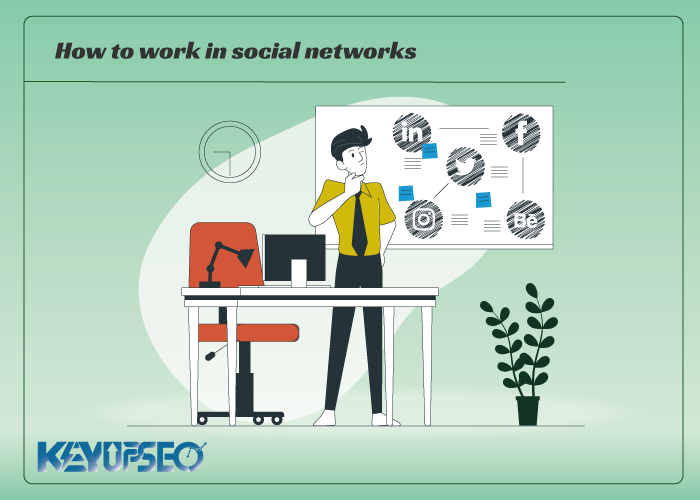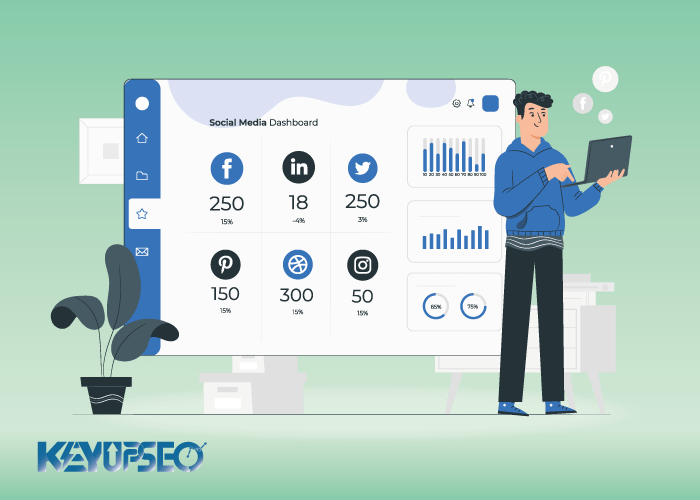
What kind of content can be published and shared on social networks?
The guide for social media activity is given in this article from the Keyupseo blog so that you can do things according to the correct principles.
With the help of this guide, you can better understand how it works and the type of content that can be published and shared on social networks.
When people start interacting with social networks, most of them make a common mistake, which is to limit their content to a variety of advertisements. This is a reflection of marketing in the traditional world, which cannot be very effective in the world of social media.
Today everything has changed. We now build our marketing efforts on trust, engagement and communities. Of course, there is a place and a time for marketing and sending promotional messages, but don't limit yourself to these things.
Try to expand your range a little. This makes your content more attractive and expands the boundaries of its creation to increase site visits. Some of the available options include:
Adjacent content
If someone is following you, they are most likely interested in what you have to offer. It can also be concluded that their interests do not end there.
Share content that is concretely related to your business and what your audience is interested in. For example, if you are a clothing retailer, you can use it on beauty trends or news from the world's great designers. Such topics can be directly aligned with the interests of your audience.
Tips and tricks
Add value to your posts by sharing content that can make your customers' lives easier. These tips and tricks can help customers use your products properly.
the answers
Not every update has to be rooted in your original ideas. You can use ideas from other people who have already posted or participate in their discussions. You can search for and participate in Twitter conversations that are relevant to your brand. This is a great way to showcase your brand and account.
Non-advertising company information
If your company is doing amazing volunteer work in the community, you can share it with other people. If you are present at exhibitions, you can provide information about it. By humanizing the brand, you can show people your internal organizational culture. Social media can be a great way to do this.
Job positions
Social networks can be a great place to find new people and bright talents. People who are looking for a job use social media to get to know their companies and job positions. List your job positions and make sure you highlight the important ones.
Jokes and humorous sentences
This option can be a little weird. First of all, know your brand and its personality. If humor can't be part of your brand, then you shouldn't be doing it. If you do this carelessly, you may lose your audience.
If you plan to use jokes in your posts, first make sure that there is no problem with participation. Make sure you don't unintentionally post jokes that are offensive.
Always be cautious and think carefully about sensitive topics. A disaster on social media can be more painful than in the real world. After you've approved a joke, make sure it's funny, because bad jokes will usually embarrass you.

How to publish and share your content?
Now you should look for it to know how to publish and share content on social media. How to publish content on social media such as Instagram, YouTube, Twitter, etc. may be different.
To get the best feedback on networks like YouTube or Instagram views, you must be able to plan and act properly.
With the help of the following tricks, you will get the best results from social networks.
Time and frequency of updates
Well, now the question is, how often should you update your content? All these things depend on the audience, what they want and what you say.
Research has been done on this topic and can be used as a general guide in your endeavours. But as with most things, it's best to test the situation yourself and see what works best for you and your audience on that platform.
There is a universal truth and that is that status updates on social media will not last long. The life of a tweet for users is about 18 minutes. This number does not mean that you can publish your post repeatedly, but you should know that your tweet will not be visible for a significant period of time.
Users are also looking for recent items in their feed. So you should know how much time your users spend on sharing and interacting on social media. This also shows the quality of your posts.
Of course, in this case, you still need to know what is useful and suitable for your organization.
For example, news organizations or different media can share many things throughout the day. This is while the clothing retailer cannot follow this pattern and posting repeatedly will be boring for users.
If you have nothing to add to your content, don't post. Of course, you should make sure that you update your account regularly so that you can encourage users to follow.
Create interaction with users
Interaction with users is very important for a brand. With the help of this option, you can respond to the mentions, questions and opinions of users. At the beginning of community development, interaction is necessary to show the brand and be active. This means that answering users' views and all their questions can be very useful. The volume of interactions at this stage is manageable for most people.
The second advantage of engagement is that it can determine the type of content strategy. When you look at people's searches and conversations in social networks, you can build your content strategy firmly based on this information.
After sharing content in your communities, you need to gather information about how your audience reacts to it and interacts with it. Include all this data in what you do.
You may want to re-evaluate when you post updates, the format and sentence structure you use, and even the type of media you use.
Seek help
Would you like your community to help you or connect with the brand in a certain way?
Sometimes you just need to ask users to do something for you. If you have been able to gain their sense of companionship by creating value and investing in relationships, you can ask these people to participate in surveys, give feedback on products, and do whatever you need them to do for you. give
These people may need to sponsor and share some of your new content or app. If you can invest in relationships, they will do something for you in return.
Keep things simple
Too many options may confuse people. If your audience is not present on a certain network, why should you promote and advertise your content on that network?
On the other hand, if your main focus is on b2b relationships, you don't need to include Pinterest as a subscription option. Look at your audience on social media and align your offers with their behavior.
Cross-promote to discover
There is nothing worse for a user than not being able to find your content properly. Cross-promotion is an easy way to prevent such problems. Make sure your blog is connected to social media. Choose the same name for all your profiles in different social channels. Create and develop a unique value proposition for each account. Why do customers need or want to follow your account on Twitter, when they are already following content on Facebook? Make sure you provide a reason for doing so.
Monitor and listen
Monitor your social channels frequently. Use services that help you receive notifications and make sure you don't miss any meaningful conversations on the web.
There are countless apps for Twitter and Facebook (such as: SocialEngage, HootSuite, TweetDeck) you can set alarms.
You can also use tools such as Fresh Web Explorer, IFTTT. Most of the different platforms provide people with this functionality in-built.
When you monitor, listen to what the customer has to say about you. Social media listening provides unlimited insights for brands and companies. This could be feedback about products, user experience, or even an alert system.
Create competition
People like and enjoy competition and they like to be rewarded for their achievements.
You can add elements such as contests to your marketing mix to stimulate your community.
Foursquare is an effective example of this that encourages its users to such processes and you can find the best for your community that is also compatible with your brand goals and can create fun interaction.
This topic can be a great way to increase the response of community members in the support forums and provide achievements for answering questions, high quality answers or sharing unanswered questions.
Align behaviors and goals with reward systems. Companies like Badgeville and BigDoor have products that help you use virtual rewards. These efforts can be done on current social media marketing and increase customer engagement, retention and loyalty while reducing the cost of customer access and customer service.

Continuous voice and branding
There are many elements involved in building a brand, but the most important thing is the promise you make to the customer. You define their experience by offering products that can meet their needs.
Remember that your company's brand helps to add tangible values to the organization and if managed properly, it will be able to take care of the investments made over time.
How people determine brand value is a complex issue. Most of us don't try to compete with valuable global brands. But surely there are many things that can be learned from these big companies.
- If you haven't developed a brand guideline yet, you should join your marketing team today and start working. After you've completed the guide, you'll need to decide how to interpret it for social media. Most visual elements such as logos and colors will remain the same. But you need to make sure that your profile users have access to creative and relevant assets. For most small to medium businesses, these may seem fanatical, but you can take inspiration from these alone. If you have a graphic design team, they should be able to help you do your job properly in this direction.
Simple guide:
-
- How your logo should be displayed.
- What are the fonts and colors that should be used and how are they used.
- A complete description of the brand and its distinguishing features.
- Situations where the brand cannot be used.
- Tone, sound and maintenance guide.
- Other topographical and structural elements.
- Know your audience: Be present in your brand, but try to adapt yourself to the environment in which you are placed. Your audience or the social platform you interact with may change your tone and voice from the guidance you've already created. This is where you need to have a proper understanding of the situation and adapt to changes if needed. You don't have to have absolute consistency between different platforms, but you do have to maintain consistency.
- Be human: This seems obvious, but it is a goal that should be considered in social media. Human interaction is very important and you should remember that the brand you develop should help you create a voice of your own. This voice is not only strong and coherent, but it is also a voice that the customer can find you with and establish a relationship based on it.
- Integrate your companies: Integrating companies in all social network profiles can help strengthen your brand and strengthen your efforts. Using the same visual elements on all profiles will help you get your message across more easily and present it to the audience in a way that is relevant and customized based on each platform.
Your social media presence is just one part of your brand that allows it to reach more people during a connected experience. This issue can be both a risk and an opportunity. That's why you should spend time deciding and defining what your brand will do on social media.
Key questions to ask yourself in this section include:
- What is the voice and personality of your brand?
- What sets you apart? What do you display?
- What is your value proposition and your differentiating factors?
- What are the defined visual elements of branding (logo, font and color)?
If you don't answer these questions first, your social media presence will face two major problems: your audience will feel like they're dealing with robots. Your community manager uses his voice in communication, which leads to a conflicted or even invalid experience.
Providing a tangible customer experience can improve people's perception.
How to gain familiarity, trust and love in our community?
Building reputation and credibility in these three areas is considered a part of the process of building relationships. We're all trying to achieve great things for our business on social media, but it's best to step back a bit.
Let's think differently. How do you build your relationships? offline or in person? Building relationships online can be a little different.
Show your presence
In the first step, you must remember to announce your presence. But everything does not end there. You have to show yourself continuously. Give people a reason to invest in their relationship with you. If you don't prove that you're in constant contact with them or you don't communicate with them regularly, they won't have a reason to stay in touch.
Be human (don't act like a robot)
Be kind, genuine and fun. Behave in such a way that people respect you and go with you. Do for your audience what you would like others to do for you.
No one can easily associate themselves with the brand personality. If people feel that your efforts are automated and lack any human touch, they will not find you likable. Remember, when interacting with someone on a social channel, it's best to assume that all interactions are completely public.
Don't be exclusive
It is better to create a balance in your relationships. You should not be selective with people. Try to treat the person you are dealing with as an individual and make them feel good.
In this way and by communicating properly with your users, you will attract their attention and you will see incredible effects in social media posts and even YouTube video likes.
Always use a variety of topics
This option is related to being human. It is better to have off-topic topics in your account sometimes. If your posts on Twitter and Facebook are only for marketing purposes, people will quickly get bored and leave your account.
Some times give up such a way. Publish something that is relevant to your business, but can be of interest to people. Again, you can use jokes. Celebrate holidays or world events. No one likes to be constantly bombarded with marketing activities.
Add value to your activities
You can make friends and show off by being cool, but remember that you are a brand now.
You need more than friends and you are networking and trying to grow your company on this platform. Adding value helps you appear useful and authentic, and ultimately makes people want you as part of their community.
Offer guidance and help, answer questions, and use your method to make people's lives easier.
Practice etiquette
Do not use hashtags as spam. Brands are already in trouble because of this issue and this issue shows that your brand is not good. People's initial understanding and feeling about you should be good. So be careful about this.
Be aware of current events
During natural disasters, inclement weather, terrorist events, and other occasions, you should pause your marketing message. If you use a scheduling service to post your posts, turn it off immediately at the first sign of such events.
If you don't, people will know you as an indifferent brand and this can have a bad effect on the brand and the company. All this will not happen to you overnight. Investing in these relationships is a long-term investment in your community and brand. Keep it updated and be patient.
If you are looking for return on investment, then invest more.
Crisis Management
We hope that no one faces a crisis in their business. Social networks can add an extra layer of complexity to this situation.
Real-world events can be amplified by social media and overshadow everything you say. Problems that occur in the customer service department can be easily and quickly spread on social platforms.
At the same time, social media can be a wonderful way to practice transparency.
When it comes to crisis management, all companies should be in one of the following 4 stages:
- Preparation: understanding existing risks, creating adaptive processes, creating responses, roles and responsibilities, training
- Response and measurement: if it is necessary to provide a response, follow, measure and monitor conditions, volumes
- Recovery: This stage generally includes more measurements, follow-up, case studies and knowledge sharing in the organization.
- Prevention: analyze the crisis and current processes, identify opportunities for improvement, acknowledge what is working well for the company.
When you are working in a crisis situation, first of all, you must understand the level of its severity, identify possible risks and gradually adjust the situation. You can work through the crisis by listening, empathizing, being transparent, and willing to correct mistakes.
After a crisis, examining the effects and gaining insights from the existing situation can help improve the situation of the organization, guide it forward and move it back to a preventive position.

Recommended tools
Measuring takes you to action. Everything we do in our company must be measured and its effectiveness confirmed. There are three main types of data for social media analysis. Some data is used between these platforms and some is outside of it.
Measurement and measurement
Account growth and competitive progress are placed in this section. Growth of followers and likes, reach of people, click rate are examples of data related to measurement.
- Crowdbooster
- Social Crawlytics
- Simply Measured
- Demographics Pro
- True Social Metrics
Listening and gaining insights
Social media gives unprecedented access to conversations. Listening tools help you acquire and use large amounts of information. The insight gained at this stage will help you gain insights into customer needs, opportunities, and even overall brand sentiment.
- Topsy
- Radian6
- Sysomos
- Vocus
- RowFeeder
Monitoring and accountability:
Marketers must be able to monitor all social media conversations for effective action. These tools generally have a built-in workflow.
Therefore, you can not only obtain information, but also act on the information obtained. This is not limited to the active post. These tools can work well as the main means of content distribution.
- BuddyMedia
- SocialEngage
- HootSuite
- Sprout Social
- Meshfire
- Buffer
Some tools are able to meet one or more of the needs we have stated. They have different price and performance. So when you want to choose one of the tools, pay attention to the type and format of the data you need to make sure you invest in something that meets your needs.
Release date : 5 July, 2023













